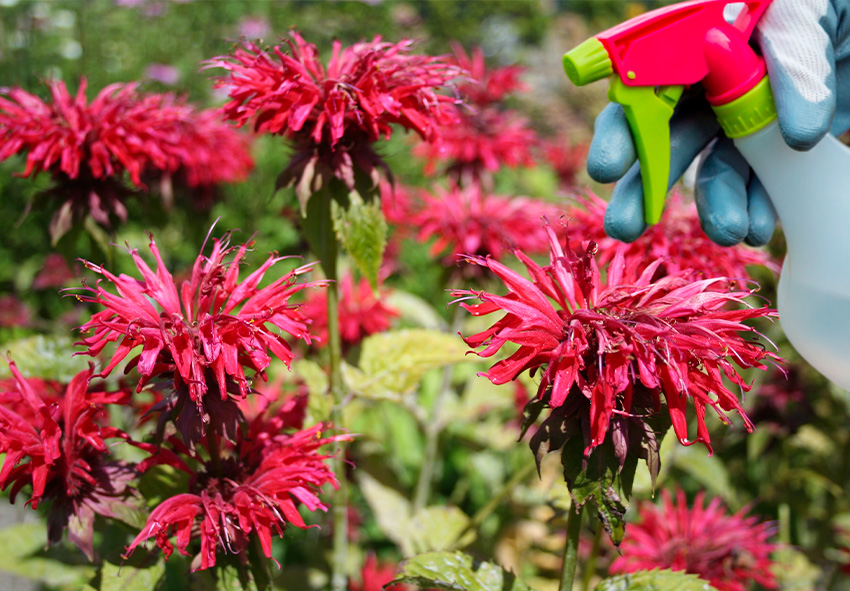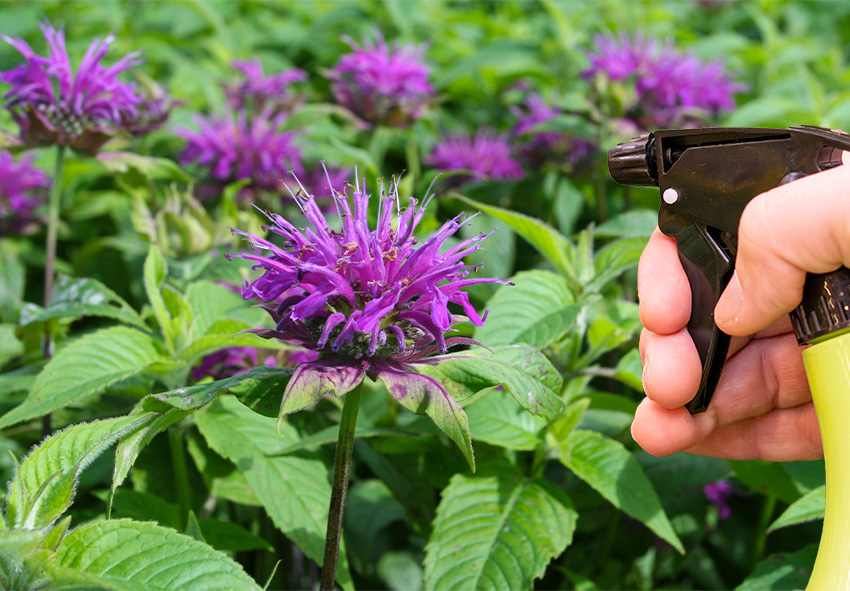Monarda, also known as bee balm, is a striking perennial known for its bright blooms and ability to attract pollinators like bees, butterflies, and hummingbirds. While it’s a hardy plant, caring for Monarda properly after planting is essential for long-term success. This guide covers watering, pruning, feeding, pest management, and seasonal tips to help your bee balm thrive. Our gardening blog is a perfect place to find all the information you need!
First Steps After Planting Monarda

The early days after planting are critical for helping Monarda become established. Providing the right conditions from the start will support strong roots and future blooming. Pay attention to watering, soil quality, and mulching for a successful start.
Initial Watering Needs
Newly planted Monarda needs steady moisture to support root development. Water the plant immediately after planting and continue watering every couple of days for the first few weeks. Early morning watering is best to reduce evaporation and help prevent fungal issues from wet foliage overnight.
Soil and Mulching Tips
Soil quality plays a big role in how well your Monarda grows. Make sure the soil is rich in organic matter and drains well to prevent waterlogging. Adding 2–3 inches of organic mulch helps retain moisture, control weeds, and regulate soil temperature around the roots.
Ongoing Watering and Feeding
Once Monarda is established, you’ll shift from daily attention to ongoing care. Proper watering and light feeding will keep the plant lush and full of blooms. This phase is about consistency and balance.
Watering Schedule for Established Plants
Once Monarda plants are fully established, their watering needs change compared to newly planted ones. While they are moderately drought-tolerant, consistent watering is still essential for vibrant growth and prolonged blooming. Here are some tips for you:
- Water once or twice a week during dry periods, depending on weather and soil drainage.
- Check soil moisture regularly by inserting your finger 1–2 inches into the soil; water if it feels dry.
- Early morning watering is best to reduce evaporation and allow foliage to dry before nightfall, helping prevent disease.
- Avoid overwatering, which can lead to root rot and fungal issues.
- Use drip irrigation or soaker hoses to deliver water directly to the base of the plant and reduce humidity around leaves.
Fertilizing Monarda
Monarda doesn’t need heavy feeding, but occasional fertilization supports vibrant growth. Use a balanced, slow-release fertilizer in early spring to jump-start the season. Avoid over-fertilizing, which can cause tall, leggy growth with fewer flowers.
Pruning and Deadheading Bee Balm
Pruning helps keep Monarda healthy and improves airflow, reducing disease risk. It also enhances the plant’s shape and promotes new flower production. Consistent deadheading and seasonal pruning are key parts of care.
Deadheading for Continued Blooming
To encourage extended blooming, remove faded flowers regularly. Snip just above a set of healthy leaves to stimulate fresh buds. This not only keeps the plant looking neat but also redirects energy into new flower development.
Seasonal Pruning Techniques
Prune Monarda back by one-third after the first round of flowering to encourage bushier growth and a possible second bloom. In late fall, cut the stems back to ground level to clear dead material and prevent overwintering pests. Early spring is also a good time for cleanup pruning before new shoots emerge.
Disease and Pest Prevention

Although Monarda is relatively hardy, it can suffer from common issues like powdery mildew or pest infestations. Staying proactive with prevention strategies will keep your plant healthy and productive. Good airflow and cleanliness are key.
Common Issues in Monarda Care
Even with proper care, Monarda (Bee Balm) can encounter a few challenges in the garden. That’s why pest and disease control for Monarda is always important for healthy growth. Recognizing these issues early can help you take quick action and maintain healthy, vibrant plants:
- Powdery Mildew: A common fungal disease causing white, powdery spots on leaves — often triggered by poor air circulation and excess moisture on foliage.
- Root Rot:Caused by overwatering or poor soil drainage. Symptoms include wilting, yellowing leaves, and mushy roots.
- Leaf Spot: Fungal or bacterial infections can create dark, discolored spots on leaves, weakening the plant over time.
- Pest Infestation: Aphids, spider mites, and Japanese beetles occasionally feed on Monarda, damaging foliage and stunting growth.
- Leggy Growth: Often a result of too little sunlight or overcrowded conditions. Monarda thrives in full sun with proper spacing.
- Reduced Flowering: Caused by lack of nutrients, too much shade, or old stems that need pruning to encourage fresh blooms.
Natural and Chemical Treatments
Spacing plants properly and avoiding overhead watering helps reduce disease pressure. Organic options like neem oil or insecticidal soap are effective against minor pest outbreaks and mildew. For severe infections, apply a garden-safe fungicide and remove infected foliage to stop the spread.
Seasonal Monarda Maintenance
Monarda care changes with the seasons to match the plant’s growth and rest cycles. Adapting your approach throughout the year helps the plant stay strong and beautiful. Each season presents opportunities for specific tasks.
Summer Care Tips
Summer is peak blooming season for Monarda, and plants need plenty of water during hot spells. Provide partial shade in extreme heat and maintain mulch to retain soil moisture. Deadhead regularly to keep the plant flowering well into the season.
Fall and Winter Prep
As temperatures cool in the fall, reduce watering and prepare Monarda for dormancy. Cut back stems to the ground after the first frost and remove debris to prevent pests and disease. Apply a thick layer of mulch to insulate the roots from freezing winter temperatures.
Encouraging Long-Term Growth

Over time, Monarda can become overcrowded or woody if not maintained. Long-term care like dividing and smart planting can extend the plant’s life and keep it blooming vigorously. This is also a great opportunity to expand your garden.
Dividing Overgrown Clumps
Every 2–3 years, divide mature Monarda clumps to rejuvenate their vigor. Dig up the root ball in early spring or fall and split it into smaller sections using a sharp spade or garden knife. Replant divisions immediately in fresh soil, and water them well to encourage rooting.
Companion Planting Ideas
Monarda (Bee Balm) pairs beautifully with many garden favorites, both for visual appeal and ecological benefit. Choosing the right companions can enhance color contrasts, attract beneficial insects, and support overall plant health:
- Echinacea (Coneflower): These bold, upright blooms complement Monarda’s shape and attract pollinators like bees and butterflies, creating a vibrant and beneficial planting duo.
- Rudbeckia (Black-Eyed Susan): Their golden-yellow flowers contrast nicely with Monarda’s reds and purples, and both thrive in similar sunny, well-drained conditions.
- Salvia: A magnet for hummingbirds, Salvia brings spiky blooms that create textural contrast when planted alongside Monarda’s fluffy flower heads.
- Phlox: Pairing Monarda with garden phlox can extend the blooming season while filling in gaps in flower beds with complementary colors.
- Yarrow: This drought-tolerant perennial not only supports pollinators but also helps suppress weeds when planted near Monarda.
- Ornamental Grasses: Tall grasses like Miscanthus or Panicum add movement and texture, balancing Monarda’s bold colors with soft, swaying greenery.
Conclusion
Caring for Monarda after planting doesn’t require perfection, just consistency and attention to its seasonal needs. With regular watering, proper pruning, and a few preventative steps, bee balm will reward you with stunning blooms and a buzz of pollinators. Enjoy its vibrant colors and long-lasting presence in your garden for years to come!
Frequently Asked Questions (FAQs) about Care for Monarda
1. How often should I water Monarda after planting?
Newly planted Monarda should be watered every couple of days for the first few weeks to help establish strong roots. As the plant matures, reduce watering to once or twice a week depending on weather and soil conditions.
2. Can Monarda bulbs be ordered from your online store?
Yes! Our online store Dutch-bulbs.com offers a selection of high-quality seeds and young plants. Please visit our website to explore our current Monarda offerings and place an order for the best option that suits your gardening needs.
3. What is the best mulch to use around Monarda?
Organic mulches such as shredded bark, straw, or compost work best for Monarda. Mulching retains moisture, controls weeds, and keeps the root zone cool — especially important in hot summers.
4. How can I prevent powdery mildew on Monarda?
Plant Monarda in well-ventilated areas and avoid overhead watering to reduce humidity around the leaves. If powdery mildew appears, treat it early with neem oil or a fungicide and remove affected foliage.
5. When and how should I divide Monarda plants?
Divide Monarda every 2–3 years in spring or fall to maintain plant health and prevent overcrowding. Carefully dig up the clump, split it into sections with healthy roots, and replant immediately with good spacing.
Published: 08.08.2025
